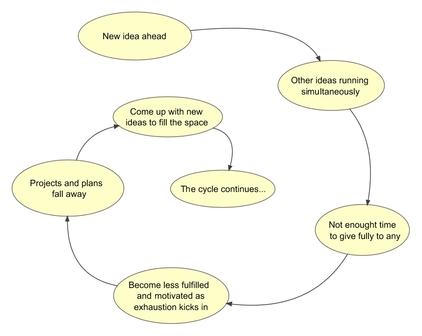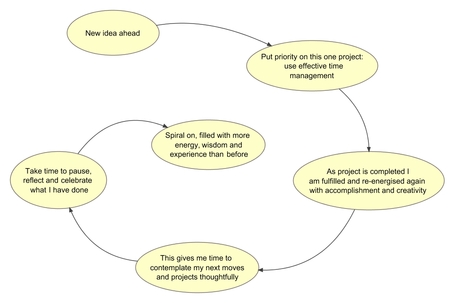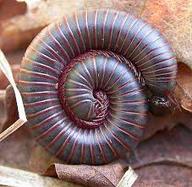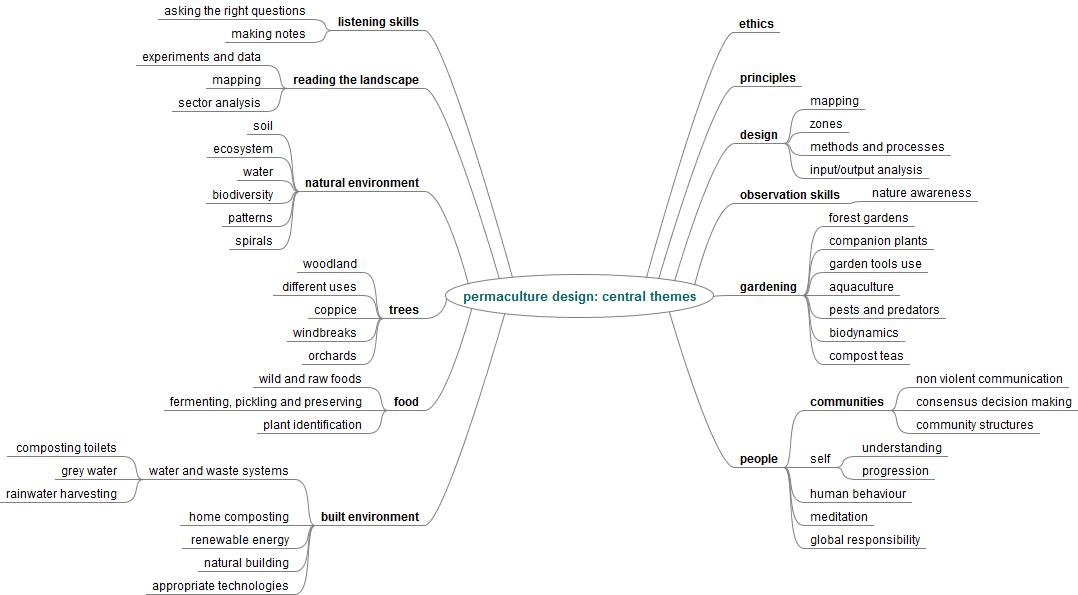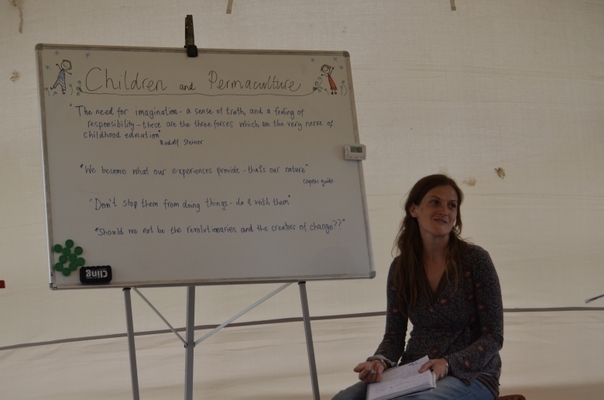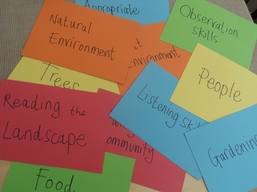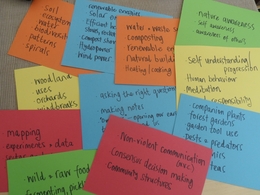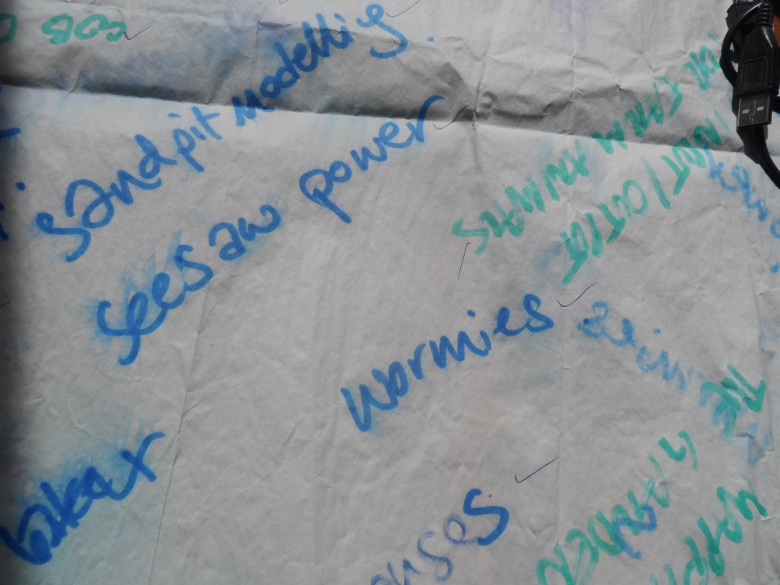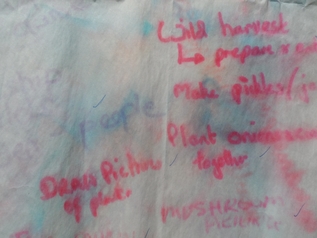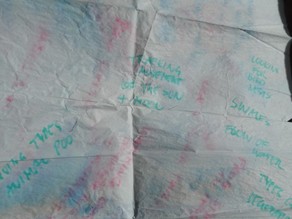Patterns
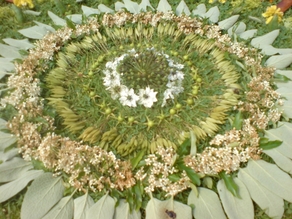 Flower mandala
Flower mandala
Around the time of the beginning of this project I jumped straight in head first and made a loose outline of the workshop that I would like to hold. I advertised it on my other website (nomadicpermaculture.weebly.com), and planned for it to be held at our land project in Spain for August 2014. Immediately I had quite a bit of interest, though mainly from friends who would like to participate. Around the same time I began to organise running Sunday classes for local children, with the same intention, sharing the essence of permaculture, whilst also immersing them in the English language. You can see the courses as they were advertised at the links here:
*Family permaculture camp plan
*Sunday afternoon classes
These pages show the feeling of the courses I am trying to create, although they got put on hold very soon afterwards, as I realised that to make our land able to host groups of families in time for the hot summer months ahead was going to be a mammoth task. Still no water on site, no power and no major shade structures, and no reliable finances coming in to source these things. And then shortly afterwards work opportunities came up for me in the UK which meant that moving back here for the rest of the year was the best option, so the Sunday classes also got put on hold. But I thought it would be useful to put links to them here as part of the planning stages.
I don't see this work as time wasted, as it will all become useful as the right time comes. I did also have a good opportunity to work out the finances for the course and working out sliding scale course prices, so I am prepared for the next time around. As this project develops I hope to add to this course idea for the Kindred Spirits camp, and make it better than it could ever have been without this projects work. Here are some images of my notes during these planning stages, which have been really useful in helping me to understand which direction to lead this project into.
*Family permaculture camp plan
*Sunday afternoon classes
These pages show the feeling of the courses I am trying to create, although they got put on hold very soon afterwards, as I realised that to make our land able to host groups of families in time for the hot summer months ahead was going to be a mammoth task. Still no water on site, no power and no major shade structures, and no reliable finances coming in to source these things. And then shortly afterwards work opportunities came up for me in the UK which meant that moving back here for the rest of the year was the best option, so the Sunday classes also got put on hold. But I thought it would be useful to put links to them here as part of the planning stages.
I don't see this work as time wasted, as it will all become useful as the right time comes. I did also have a good opportunity to work out the finances for the course and working out sliding scale course prices, so I am prepared for the next time around. As this project develops I hope to add to this course idea for the Kindred Spirits camp, and make it better than it could ever have been without this projects work. Here are some images of my notes during these planning stages, which have been really useful in helping me to understand which direction to lead this project into.
Looking back now, I can see a very clear pattern that occurs often within my life and circumstances. Of trying to achieve a goal without the supportive structures in place to help me. It seems I'm always looking for the challenge, if things seem easy and relaxing then I often find myself filling my time with a dozen more tasks to do so that I become overwhelmed with the weight and find it hard to get these things done. I also rarely take the time to pause and celebrate what I have completed, and continue to plough on when I really need to take a rest.
I think you could call this a spiral of erosion.
Below I've drawn out this spiral, and then looked at how I can turn it into a spiral of abundance.
I think you could call this a spiral of erosion.
Below I've drawn out this spiral, and then looked at how I can turn it into a spiral of abundance.
A moment of appreciation
Right now I am appreciating the fact that I have decided to face this pattern within myself alongside the habit of often living in ways that do not support working and studying and connecting with others. This move away from the land for a while is a large leap in putting priority on my ascent into productively moving forward with my intentions and goals. A relatively easy life for a while, with time devoted to working. Bliss! Abundance here I come..
A framework for conscious permaculture teaching; applying the permaculture principles to working with children
I feel that I would now like to create a set of guidelines of how I would like to interact with children in my workshops and how I can best guide and support them. This way I can ensure that I only develop lessons that fit into these ethics and fulfil my needs for conscious teaching.
I thought I would use the principles of permaculture design and look at how I can use these as guidance to working with children in my own way. And I have just come across an article in Juno magazine (Issue 35, written by Juliet Kemp) that applies the principles to parenting. In her article she points out that
"Permaculture parenting is about creating sustainable cycles in our families lives, and positive interactions between us, our children and our world."
I think that this statement can apply very well to any aspect of being with children, both as a parent and as a teacher.
I am going to work from this article and look at how it relates to teaching. I think this may be a good thing to focus on now as then it will set an intention for all lesson planning to come.
I've put my interpretation of the principles related to childhood education on a separate page, you can find it at the link below;
*Click here for the principles of permaculture applied to childhood education*
I thought I would use the principles of permaculture design and look at how I can use these as guidance to working with children in my own way. And I have just come across an article in Juno magazine (Issue 35, written by Juliet Kemp) that applies the principles to parenting. In her article she points out that
"Permaculture parenting is about creating sustainable cycles in our families lives, and positive interactions between us, our children and our world."
I think that this statement can apply very well to any aspect of being with children, both as a parent and as a teacher.
I am going to work from this article and look at how it relates to teaching. I think this may be a good thing to focus on now as then it will set an intention for all lesson planning to come.
I've put my interpretation of the principles related to childhood education on a separate page, you can find it at the link below;
*Click here for the principles of permaculture applied to childhood education*
The different elements of permaculture design
I thought it would be very beneficial here now to look at what elements of Pc design are important and relevant to include in a family workshop. If I make a list of general course content, I can then begin to create lesson plans around these core ideas.
Here's the map covering the different areas of permaculture design. I'm sure there are many more things that could be included, but for now this gives a starting point.
Here's the map covering the different areas of permaculture design. I'm sure there are many more things that could be included, but for now this gives a starting point.
Harvesting wisdom
I have just attended a teacher training course this June with Designed Visions. This has totally influenced and inspired me, in so many ways. I have increased my confidence as a teacher, and expanded my knowledge with new teaching techniques and methods. I also got to lead a practice micro-teach on children and permaculture. In this session I took advantage of 'harvesting the wisdom of the group'.. By this I mean that within our group there was a wide range of people with a wide range of experiences. Educators, farmers, travellers, ecologists, people from many different walks of life, and many of them parents as well. The thing that connected everybody was their love and passion for permaculture and developing ways to share this with others.
For me, this was an amazing opportunity, to be in control of some time with this wonderful group of people and to share our ideas of how we can enjoy permaculture design with children. In one part of the micro-teach that I led I wrote out the breakdown of the areas of permaculture (as drawn out in the mind-map above), onto coloured card and shared these out into groups. I then asked everybody to write down their ideas of how each of these areas could be best experienced with a child. A multi-functional exercise for me, as this session not only gave me teaching practice, but I was able to leave with three large sheets of paper with many ideas written down from so many different and valuable sources. Great stuff!
Unfortunately, as I went back to Spain and excitedly shared all of my new resources with a friend, I left the papers outside on my garden table where a few minutes later they got turned into watercolour paintings by an unexpected storm. Thankfully I did manage to salvage and interpret most of the smeared blurs after drying them over the burner that night... Here are the ideas that I rescued.
Unfortunately, as I went back to Spain and excitedly shared all of my new resources with a friend, I left the papers outside on my garden table where a few minutes later they got turned into watercolour paintings by an unexpected storm. Thankfully I did manage to salvage and interpret most of the smeared blurs after drying them over the burner that night... Here are the ideas that I rescued.
|
|
From this exercise I now have a great starting point with some ideas of child based activities filling up some of the areas of permaculture design. I'll come back to these ideas and add them to my other resources when I'm designing my lesson plans.
continue onto the next page, the analysis, here
